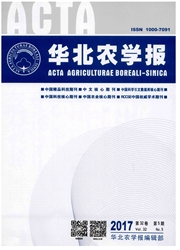

 中文摘要:
中文摘要:
研究了控制双亲混合选择和半同胞-S2:3(HS-S2:3)轮回选择对2个玉米基础群体P4C0和P5C0主要性状的改良效果。结果表明,对于基础群体P4C0,其改良群体P4HSC1、P4MSC1和P4MSC2的单株产量分别比P4C0提高21.64%,10.29%和8.70%,达显著或极显著水平;对于基础群体P5C0,其改良群体P5HSC1的单株产量比P5C0降低7.53%,达显著水平;改良群体P5MSC1和P5MSC2平均单株产量变化与P5C0相比,分别降低和提高了2.67%和3.65%,均未达到显著水平。控制双亲混合选择改良群体,其产量的显著改进伴随着株高和穗位商的显著增加;HS—S2:3轮回选择改良群体,不同基础群体,其产量和株高、穗位高的改良效果不同。两种选择方法改良群体,多数性状的表型变异系数随着选择的进行有所下降,但也有部分性状变异系数变化较小或有所增大,群体内仍保持了较丰富的遗传变异,且以控制双亲混合选择保持群体遗传多样性的效果更好。
 英文摘要:
英文摘要:
In this article,the effects of biparental mass selection(MS)and half-sib-S3 family combining selection( HS-S2:3) on the major traits of the two maize populations were studied. The results indicated that the increase of grain yield per plant of P4HSC1,P4MSC1 and P4MSC2 was 21.64%, 10.29% and 8.70% compare to that of P4C0,respectively,a significant or extreme significant progress was made. There was a significant decrease for 7. 53% compare to that of P5C0 in grain yield per plant of P5HSC1. The increase of grain yield per plant of P5MSC1 and P5MSC2 was -2.67% and 3.65% ,the difference was not significant. The height of plant and ear increased significantly with the increase of grain yield in a mass selection program. The effects of HS-S2:3 on the height of plant and ear were different for the two populations. The performance of major traits changed and the phenotypic variation coefficients of most traits decreased with the advance of improvement. The MS was better in maintaining the genetic diversity of populations.
 同期刊论文项目
同期刊论文项目
 同项目期刊论文
同项目期刊论文
 期刊信息
期刊信息
